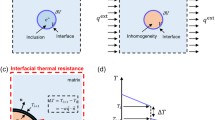Abstract
A general interface model is presented for thermal conduction and characterized by two jump relations. The first one expresses that the temperature jump across an interface is proportional to the interfacial average of the normal heat flux while the second one states that the normal heat flux jump is proportional to the surface Laplacian of the interfacial average of the temperature. By varying the two scalar proportionality parameters, not only the Kapitza resistance and highly conducting interface models can be retrieved but also all the intermediate cases can be covered. The general interface model is numerically implemented by constructing its weak form and by using the level-set method and XFEM. The resulting numerical procedure, whose accuracy and robustness are thoroughly tested and discussed with the help of a benchmark problem, is shown to be efficient for solving the problem of thermal conduction in particulate composites with various imperfect interfaces.




















Similar content being viewed by others
References
Kapitza PL (1941) Heat transfer and superfluidity of helium II. Phys Rev 60:354–355. doi:10.1103/PhysRev.60.354
Johnson R, Little W (1963) Experiments on the Kapitza resistance. Phys Rev 130:596–604. doi:10.1103/PhysRev.130.596
Pollack GL (1969) Kapitza resistance. Rev Mod Phys 41:48–81. doi:10.1103/RevModPhys.41.48
Nan CW, Birringer R (1998) Determining the Kapitza resistance and the thermal conductivity of polycrystals: a simple model. Phys Rev B 57:8264–8268. doi:10.1103/PhysRevB.57.8264
Yvonnet J, He QC, Zhu QZ, Shao JF (2011) A general and efficient computational procedure for modelling the Kapitza thermal resistance based on XFEM. Comput Mater Sci 50:1220–1224. doi:10.1016/j.commatsci.2010.02.040
Le-Quang H, He QC (2011) Eshelby’s tensor fields and effective conductivity of composites made of anisotropic phases with Kapitza’s interface thermal resistance. Philos Mag 91:3358–3392
Javili A, McBride A, Steinmann P (2012) Numerical modelling of thermalmechanical solids with mechanically energetic (generalised) Kapitza interfaces. Comput Mater Sci 65:542–551. doi:10.1016/j.commatsci.2012.06.006
Cheng H, Torquato S (1997) Effective conductivity of dispersions of spheres with a superconducting interface. Proc R Soc Lond Ser A 453:1331–1344. doi:10.1098/rspa1997.0009 1997.0009
Lipton R (1997) Variational methods, bounds and size effects for composites with highly conducting interface. J Mech Phys Solids 45:361–384. doi:10.1016/S0022-5096(96)00097-X
Lipton R (1997) Reciprocal relations, bounds, and size effects for composites with highly conducting interface. SIAM J Appl Math 57:342–363. doi:10.1137/S0036139995291180
Duan HL, Karihaloo BL (2007) Effective thermal conductivities of heterogeneous media containing multiple imperfectly bonded inclusions. Phys Rev B 75:064206. doi:10.1103/PhysRevB.75.064206
Yvonnet J, He QC, Toulemonde C (2008) Numerical modelling of the effective conductivities of composites with arbitrarily shaped inclusions and highly conducting interface. Compos Sci Technol 68:2818–2825. doi:10.1016/j.compscitech.2008.06.008
Le-Quang H, Bonnet G, He QC (2010) Size-dependent Eshelby tensor fields and effective conductivity of composites made of anisotropic phases with highly conducting imperfect interfaces. Phys Rev B 81:064203. doi:10.1103/PhysRevB.81.064203
Javili A, McBride A, Steinmann P (2013) Numerical modelling of thermomechanical solids with highly conductive energetic interfaces. Int J Numer Method Eng 93:551–574. doi:10.1002/nme.4402
Belytschko T, Black T (1999) Elastic crack growth in finite elements with minimal remeshing. Int J Numer Method Eng 45:601–620. doi:10.1002/(SICI)1097-0207(19990620)
Moës N, Dolbow J, Belytschko T (1999) A finite element method for crack growth without remeshing. Int J Numer Method Eng 46:131–150. doi:10.1002/(SICI)1097-0207(19990910)
Belytschko T, Moës N, Usui S, Parimi C (2001) Arbitrary discontinuities in finite elements. Int J Numer Method Eng 50:993–1013. doi:10.1002/1097-0207(20010210)
Ji H, Dolbow JE (2004) On strategies for enforcing interfacial constraints and evaluating jump conditions with the extended finite element method. Int J Numer Method Eng 61:2508–2535. doi:10.1002/nme.1167
Benvenuti E (2008) A regularized XFEM framework for embedded cohensive interfaces. Comp Method Appl Mech Eng 197:4367–4378. doi:10.1016/j.cma.2008.05.012
Yvonnet J, Le-Quang H, He QC (2008) An XFEM/level set approach to modelling surface/interface effects and to computing the size-dependent effective properties of nanocomposites. Comput Mech 42:119–131. doi:10.1007/s00466-008-0241-y
Nistor I, Guiton MLE, Massin P, Moës N, Gé niaut S (2009) An X-FEM approach for large sliding contact along discontinuities. Int J Numer Method Eng 78:1407–1435. doi:10.1002/nme.2532
Cheng KW, Fries TP (2010) Higher-order XFEM for curved strong and weak discontinuities. Int J Numer Method Eng 82:564–590. doi:10.1002/nme.2768
Farsad M, Vernerey FJ, Park HS (2010) An extended finite element/level set method to study surface effects on the mechanical behavior and properties of nanomaterials. Int J Numer Method Eng 84:1466–1489. doi:10.1002/nme.2946
Fries TP, Belytschko T (2010) The extended/generalized finite element method: an overview of the method and its applications. Int J Numer Method Eng 84:253–304. doi:10.1002/nme.2914
Zhu QZ, Gu ST, Yvonnet J, Shao JF, He QC (2011) Three-dimensional numerical modelling by XFEM of spring-layer imperfect curved interfaces with applications to linearly elastic composite materials. Int J Numer Method Eng 88:307–328. doi:10.1002/nme.3175
Sussmann C, Givoli D, Benveniste Y (2011) Combined asymptotic finite-element modelling of thin layers for scalar elliptic problems. Comput Method Appl Mech Eng 200:3255–3269. doi:10.1016/j.cma.2011.08.001
Sanchez-Palencia E (1970) Comportement limite d’un probl ème de transmission à travers une plaque faiblement conductrice. C R Acad Sci Ser A 270:1026–1028
Pham HP, Sanchez-Palencia E (1974) Phénomènes de transmission a travers des couches minces de conductivité élevé e. J Math Anal Appl 47:284–309
Hashin Z (2001) Thin interphase/imperfect interface in conduction. J Appl Phys 89:2261–2267. doi:10.1063/1.1337936
Benveniste Y (2006) A general interface model for a three-dimensional curved thin anisotropic interphase between two anisotropic media. J Mech Phys Solids 54:708–734. doi:10.1016/j.jmps.2005.10.009
Gu ST, He QC (2011) Interfacial discontinuity relations for coupled multifield phenomena and their application to the modeling of thin interphases as imperfect interfaces. J Mech Phys Solids 59:1413–1426. doi:10.1016/j.jmps.2011.04.004
Gu ST, Yang D, He QC (2013) Modelling of thermal imperfect interfaces: beyond Kapitza resistance and highly conducting models. (submitted)
Dolbow J, Harari I (2009) An efficient finite element method for embedded interface problems. Int J Numer Method Eng 78:229–252. doi:10.1002/nme.2486
Harari I, Dolbow J (2010) Analysis of an efficient finite element method for embedded interface problems. Comput Mech 46:205–211. doi:10.1007/s00466-009-0457-5
Gu ST, Monteiro E, He QC (2011) Coordinate-free derivation and weak formulation of a general imperfect interface model for thermal conduction in composites. Compos Sci Technol 71:1209–1216. doi:10.1016/j.compscitech.2011.04.001
Gurtin ME, Murdoch AI (1975) A continuum theory of elastic material surfaces. Arch Ration Mech Anal 57:291–323. doi:10.1007/BF00261375
Belytchko T, Parimi C, Moës N, Sukumar N, Usui S (2003) Structured extended finite element method for solids defined by implicit surfaces. Int J Numer Method Eng 56:609–635. doi:10.1002/nme.686
Chessa J, Wang HW, Belytschko T (2003) On the construction of blending elements for local partition of unity enriched finite elements. Int J Numer Method Eng 57:1015–1038. doi:10.1002/nme.777
Fries TP (2008) A corrected XFEM approximation without problems in blending elements. Int J Numer Method Eng 75:503–532. doi:10.1002/nme.2259
Acknowledgments
This work is partially supported by the National Natural Science Foundation of China (Grant Number 11202173), the Fundamental Research Funds for the Central Universities (Grant Number SWJTU11CX027) and the Postdoctoral Science Foundation of China (Grant Number 2013M530406).
Author information
Authors and Affiliations
Corresponding authors
Rights and permissions
About this article
Cite this article
Liu, J.T., Gu, S.T., Monteiro, E. et al. A versatile interface model for thermal conduction phenomena and its numerical implementation by XFEM. Comput Mech 53, 825–843 (2014). https://doi.org/10.1007/s00466-013-0933-9
Received:
Accepted:
Published:
Issue Date:
DOI: https://doi.org/10.1007/s00466-013-0933-9




